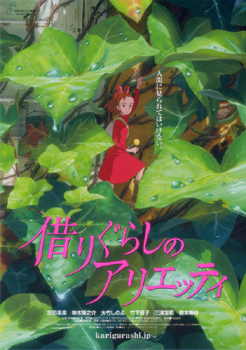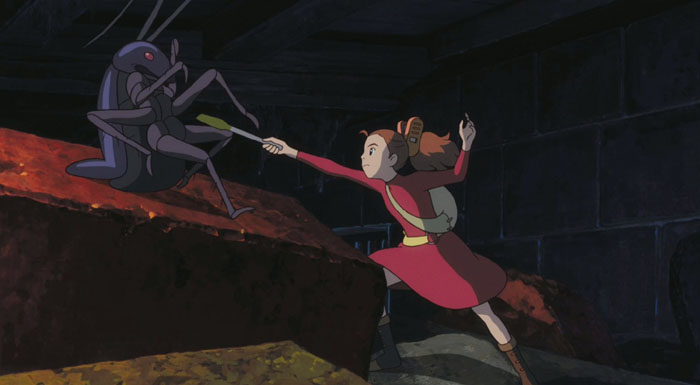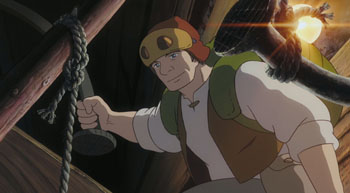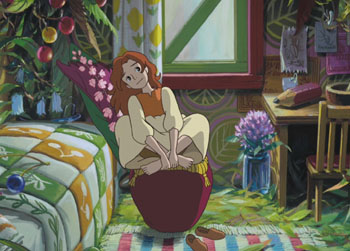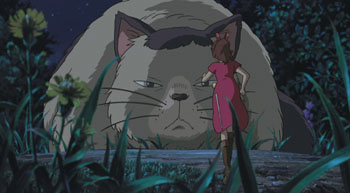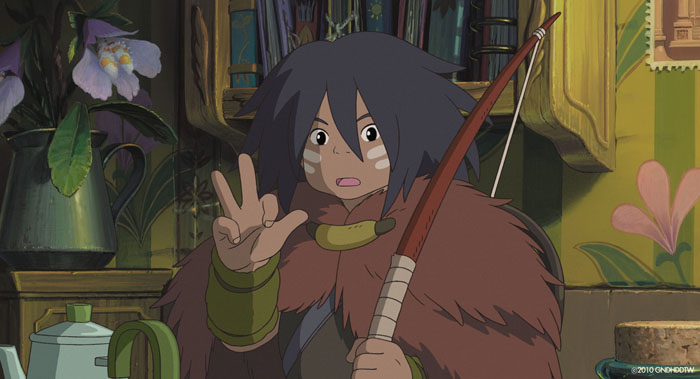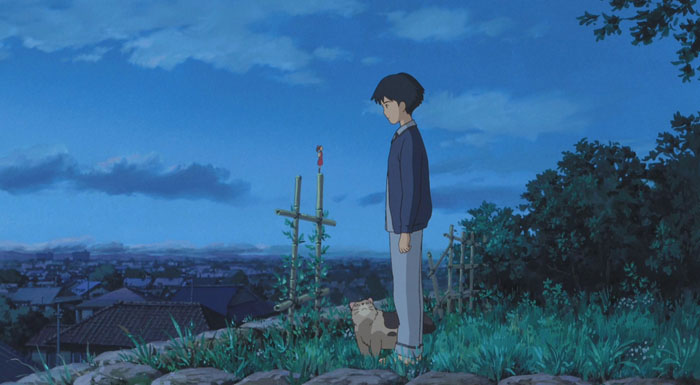 The tiny borrower Arrietty lives hidden in a modern world in the Studio Ghibli animated feature ARRIETTY. © 2010 GNDHDDTW
The tiny borrower Arrietty lives hidden in a modern world in the Studio Ghibli animated feature ARRIETTY. © 2010 GNDHDDTWProduction Details for the Studio Ghibli Animated Feature Source: Madman Entertainment Official Movie Site: karigurashi.jp (Japan), arrietty.com.au (Australia), disney.go.com/arrietty (US) The animated feature ARRIETTY (????????????, Karigurashi no Arrietty, 2010) was another smash hit for Studio Ghibli, topping the Japanese box office for 2010. Based on Mary Norton’s novel The Borrowers, ARRIETTY is now being released theatrically in two major English language markets; Madman Entertainment will open the film in Australian cinemas on January 12, 2012, and Walt Disney Studios will release it in North America as THE SECRET WORLD OF ARRIETTY on February 17. The following English language press notes for ARRIETTY are courtesy of Madman Entertainment...
ARRIETTY
A film by HIROMASA YONEBAYASHI 2010 · JAPAN · RUNNING TIME 94 MINS · 35 MM · 1:1.85 · DOLBY SR-SRD · COLOR
SYNOPSIS
This is a story of a family of “little” people. Beneath the floorboards of a sprawling mansion set in a magical, overgrown garden in the suburbs of Tokyo, tiny 14-year-old Arrietty lives with her equally tiny parents. The house is occupied by two old ladies, who are absolutely unaware of the existence of their miniature tenants. Arrietty and her family live by “borrowing”. Everything they have, they borrow or make from the things they have borrowed. Essentials like gas, water and food. Tables, chairs, cooking utensils. And treats - a sugar cube here, a scrap of material there. But only a little each time, so the ladies do not notice. A 12-year-old boy, Sho, moves into the mansion while he waits for urgent medical treatment in the city. Arrietty’s parents have always warned her: “Never let humans see you.” Once seen, little people always have to move on. But the adventurous Arrietty doesn’t listen, and Sho discovers her. The two begin to confide in each other and, before long, a friendship begins to blossom...
HIROMASA YONEBAYASHI: Director’s Biography
Born in 1973 in Ishikawa-ken, Japan, Hiromasa Yonebayashi attended Business Design from Kanazawa College of Art. In 1996 Yonebayashi joined Studio Ghibli and worked as an ‘In-between’ Animator on PRINCESS MONONOKE (1997) and MY NEIGHBORS THE YAMADAS (1999), and as Key Animator on SPIRITED AWAY (2001), THE GHIBLIES EPISODE 2 (2002), HOWL’S MOVING CASTLE (2004) and PONYO ON THE CLIFF BY THE SEA (2008). He was also Assistant Supervising Animator on TALES FROM EARTHSEA (2006). Besides working on Ghibli’s animated features, Yonebayashi has worked on short films for the Ghibli Museum, Mitaka. He was Director of Animation on MEI AND THE BABY CATBUS (2002), and Supervising Animator on IMAGINARY FLYING MACHINES (2002), and was also responsible for storyboarding and directing EVOLUTION (2008), one of the Ghibli Museum’s attractions in the FILMS GO ROUND display. Yonebayashi makes his debut as the director of a feature animated film with Studio Ghibli’s latest production ARRIETTY.
PROJECT PROPOSAL: Producer Toshio Suzuki
I believe it was early in the summer of 2008 that Hayao Miyazaki first suggested this project. Meanwhile, I had another idea for a film in mind. We repeatedly argued and debated, and neither of us would budge. I could see we weren’t getting anywhere so, out of respect for Mr. Miyazaki’s seniority, I gave in.
Nearly forty years ago Miyazaki-san and Isao Takahata had wanted to adapt The Borrowers. One day Miyazaki- san happened to recall this, strongly recommended that I read the books and began pushing quite persistently for making it into a film. Perhaps it was out of fond memories for his and Takahata-san’s younger days, I don’t know... these kinds of things come up now and then at Studio Ghibli. “But why The Borrowers now?” I asked Miyazaki-san, and he began giving me various justifications for making the film. The idea of the story being about “borrowing” is intriguing. It fits perfectly with the way things are today. The era of mass consumption is coming to a close. We are in a bad economy and the idea of borrowing instead of buying shows very well the direction things are headed, he explained. Miyazaki-san likes to act quickly when he thinks he has a good idea, so wrote a formal project proposal for me immediately. The setting will be changed from 1950s England to modern-day Japan of 2010. Our familiar Koganei neighborhood would be fine as its location. Living under the kitchen floor of an old house is a family of little people - a 14-year-old girl named Arrietty, and her parents. The little people get all their daily necessities by “borrowing” from the human beings who live above the floor. They are not fairies and do not possess any magical powers.
They fight off mice, are troubled by cockroaches and termites, escape from fumigation and insect sprays, and sidestep cockroach traps and bait laced with boric acid. The little people lead modest and careful lives, cautious not to be seen or attract attention. The father is brave and strong, going out on dangerous “borrowing” missions. With a sense of responsibility for the family, the mother protects and manages the home. Arrietty is a sensitive girl with an inquisitive mind. We find in them the ways of an old-fashioned traditional family. The normal, mundane world is refreshingly seen anew when viewed through the eyes of people who are 10cm (4 inches) tall. The little people working and moving and using their whole bodies will be wonderful to animate. The story will portray the daily life of the little people: their meetings, exchanges and the parting of Arrietty and a human boy who has befriended her; and will also show how the little people escape a calamity inflicted on them by a cruel human being and are forced to go and live outside in the fields. In hope that this work will offer comfort and courage to the people living in these chaotic, unsure times... The film was initially titled CHIISANA ARRIETTY (Little Arrietty). I thought that was a bold choice and asked him the reason for this title. Miyazaki-san told me that he liked the sound of “Arrietty”, and therefore he never forgot the name. Yet, this title does not mention the “borrowing” that Miyazaki-san had insisted was the main justification for making the film. When I pointed that out to him, Miyazaki-san immediately changed the title to KARIGURASHI NO ARRIETTY (Arrietty the Borrower).
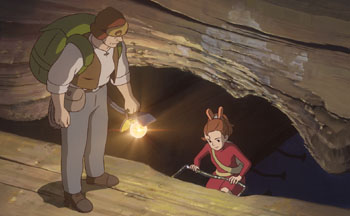 Arrietty goes on a borrowing expedition with her dad. Image courtesy of Madman Entertainment. © 2010 GNDHDDTW
Arrietty goes on a borrowing expedition with her dad. Image courtesy of Madman Entertainment. © 2010 GNDHDDTWSo the next question was, who will direct it? This was a tough one. Studio Ghibli had managed to produce almost all of its films up to now by having Isao Takahata and Hayao Miyazaki take turns directing. But now they were both old. There is a saying that goes “old in years but going strong”, but as a practical matter there is only so much an older man can do beyond a certain point. So, just as we had young Goro Miyazaki direct TALES FROM EARTHSEA, we needed a younger director for this project. Who was going to do it? In such situations, Miyazaki-san would suddenly treat me as the person solely in charge of the studio, and not consider that such a question might require a bit of time for thinking. The only name that came to mind on the spur of the moment was the name of our present director Hiromasa Yonebayashi. “Maro” is his nickname. “How about Maro?” I said. Miyazaki-san looked astonished. “Suzuki-san, how long have you been thinking about this?” he asked. “Maybe since two or three years ago,” I lied. I had never even asked Maro if he had ever considered directing. I simply gave his name because I was on the spot. Maro, incidentally, is Ghibli’s best animator. For PONYO ON THE CLIFF BY THE SEA he was in charge of the scene where Ponyo comes running in on a series of huge waves trying to find Sosuke, and his animation impressed Miyazaki-san. “Well, let’s have him over and we will talk!” Once he has decided, Miyazaki-san is swift to act. He summoned Maro to his Nibariki Studio so we could convince him to take on the job.
Miyazaki-san came directly to the point. He showed Maro a copy of The Borrowers and said, “Maro, this is our next project, and you will direct it!” Maro, who rarely changes his expression, was caught by surprise. “But doesn’t a director need his own philosophy or point of view?” he asked. “I don’t have that.” Miyazaki-san and I cried out in unison “That’s already in the book!” Maro was dumbstruck, but eventually, he accepted Miyazaki-san’s decision and his role as director. At first, Maro would try to gauge Miyazaki-san’s opinions on everything, but when it was time to draw the storyboards, he realized that he had to face it alone, and informed Miyazaki-san that he would not seek his advice anymore. Miyazaki-san responded with “That’s my boy! Be brave!” and encouraging things like that. So now, all Ghibli’s production staff is fully engaged in making this film based on Maro’s storyboards. Things are proceeding smoothly for now, but our only worry is Miyazaki-san. Maro is surely on his mind, and you never know when Miyazaki-san may come storming into the production area with unsolicited advice and new ideas.
ABOUT THE BOOK
The Borrowers is the first in a series of children’s fantasy novels by Mary Norton. Published in 1952, it won the Library Association’s Carnegie Medal for that year, and in 2007 it was selected by judges of the CILIP Carnegie Medal for children’s literature, as one of the ten most important children’s novels of the past 70 years. The other novels in the Borrowers series are The Borrowers Afield (1955), The Borrowers Afloat (1959), The Borrowers Aloft (1961) and The Borrowers Avenged (1982). Mary Norton was born in 1903 and brought up in a house in Bedfordshire, which was to become the setting for The Borrowers. She began writing while working for the British Purchasing Commission in New York during the Second World War. Her first book was The Magic Bed Knob, published in 1943, which, together with the sequel Bonfires and Broomsticks, became the bases for the 1971 film BEDKNOBS AND BROOMSTICKS, starring Angela Lansbury. Poor Stainless was the last Borrowers story Mary Norton wrote before she died in 1992.
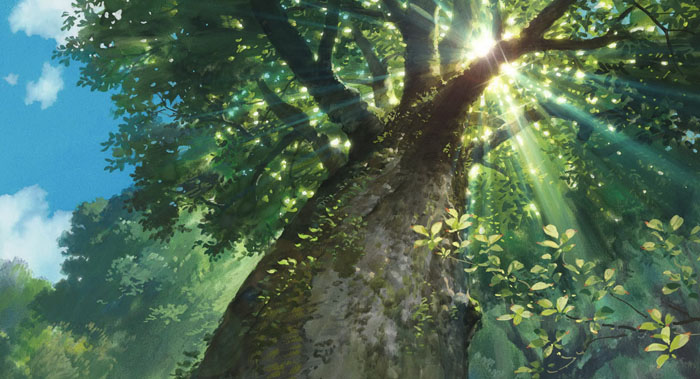 ARRIETTY features the gorgeous painted backgrounds which have become a Studio Ghibli hallmark. © 2010 GNDHDDTW
ARRIETTY features the gorgeous painted backgrounds which have become a Studio Ghibli hallmark. © 2010 GNDHDDTWTHE HISTORY OF STUDIO GHIBLI
Established in 1985 by Tokuma Shoten Publishing, Studio Ghibli is an animation studio based in Japan and helmed by Hayao Miyazaki and Isao Takahata. Tokuma Shoten had been serialising Miyazaki’s manga version of Nausicaä of the Valley of the Wind since 1982. The following year they decided to produce a film version of NAUSICAA OF THE VALLEY OF THE WIND to be directed by Miyazaki himself. When the film was released in Japan in 1984, it proved such a success that Tokuma decided to create a studio dedicated to the production of high quality animated feature films like NAUSICAA. Ghibli is unique among Japanese animation companies, most of whom develop TV series and original programming. Becaude they focus on large-scale feature films, Studio Ghibli makes around one film every two years, most of which have been directed by either Miyazaki or Takahata. The Studio has won numerous awards, including an Oscar for Best Animated Feature for SPIRITED AWAY, and has enjoyed considerable box office success both internationally and in Japan (where SPIRITED AWAY proved more popular than TITANIC).
JAPANESE VOICE CAST
Arrietty: Mirai Shida Sho: Ryunosuke Kamiki Homily: Shinobu Otake Sadako Maki: Keiko Takeshita Spiller: Tatsuya Fujiwara Pod: Tomokazu Miura Haru: Kirin Kiki
ENGLISH VOICE CAST
Arrietty: Saoirse Ronan (UK), Bridgit Mendler (US) Sho/Shawn: Tom Holland (UK), David Henrie (US) Homily: Olivia Colman (UK), Amy Poehler (US) Sadako Maki/Jessica: Phyllida Law (UK), Carol Burnett (US) Spiller: Luke Allen-Gale (UK), Moisés Arias (US) Pod: Mark Strong (UK), Will Arnett (US) Haru: Geraldine McEwan (UK), Gracie Poletti (US)
CREW
Development and Screenplay: Hayao Miyazaki Producer: Toshio Suzuki Director: Hiromasa Yonebayashi Screenplay: Keiko Niwa Executive Producer: Koji Hoshino Music: Cécile Corbel Supervising Animators: Megumi Kagawa, Akihiko Yamashita Art Directors: Yoji Takeshige, Noboru Yoshida Color Design: Naomi Mori Director of Digital Imaging: Atsushi Okui Editing: Rie Matsubara Sound Designer/ Sound Re-recording Mixer: Koji Kasamatsu ADR Director: Eriko Kimura
For more information on ARRIETTY, please see the earlier coverage here on SciFi Japan:
- Studio Ghibli`s THE SECRET WORLD OF ARRIETTY Gets American Theatrical Release from Disney
- Studio Ghibli`s ARRIETTY Opens in Australia on January 12th
- NYICFF Special Preview Screening: THE SECRET WORLD OF ARRIETTY


